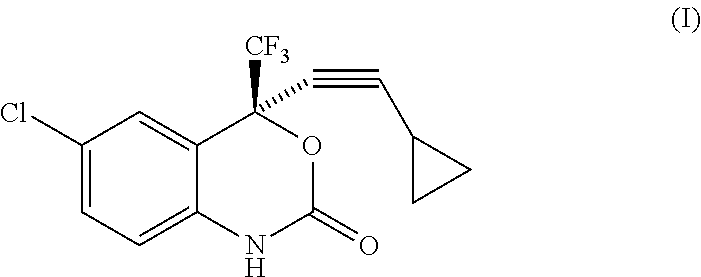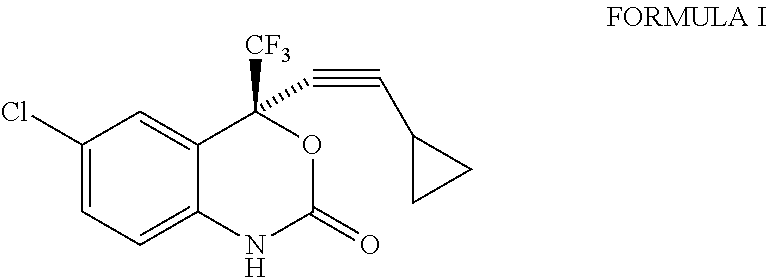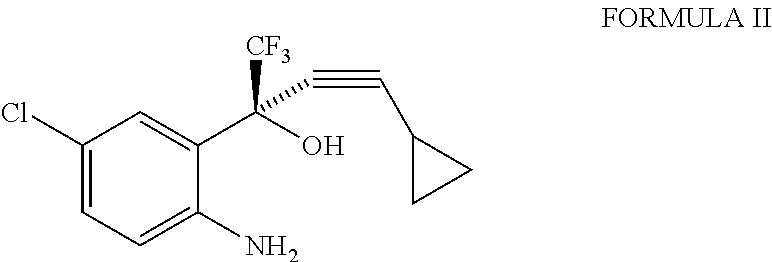Process for the preparation of efavirenz
- Summary
- Abstract
- Description
- Claims
- Application Information
AI Technical Summary
Benefits of technology
Problems solved by technology
Method used
Image
Examples
example 1
Preparation of Efavirenz
Toluene (400 ml) was added to (2S)-2-(2-amino-5-chlorophenyl)-4-cyclopropyl-1,1,1-trifluorobut-3-yn-2-ol (100 g) at 20° to 25° C. and the reaction mixture was cooled to 10° C. Aqueous potassium bicarbonate solution (74.61 g in 300 ml of de-ionized water) was added to the reaction mixture in 10 to 15 minutes. Triphosgene (36.870 g pre-dissolved in 150 ml of toluene) was subsequently added to the reaction mixture in 45 to 75 minutes at 10° to 25° C. The reaction mixture was stirred at 10° to 25° C. for 60 minutes and the reaction mixture was quenched with methanol (7 ml) at 10° to 25° C. (All the above reaction steps were carried out under nitrogen atmosphere). The layers were separated and the organic layer was washed with de-ionized water followed by dilute hydrochloric acid. The solvent was recovered under reduced pressure and the solid obtained was re-crystallized with methanol: water (3:9) at 25° to 30° C. The solid was dried under reduced pressure at 85° ...
example 2
Preparation of Efavirenz
Toluene (700 ml) was added to (2S)-2-(2-amino-5-chlorophenyl)-4-cyclopropyl-1,1,1-trifluorobut-3-yn-2-ol (100 gm) at 20° to 25° C. and the reaction mixture was cooled to 10° C. Triphosgene (36.870g) was added as a solid to the reaction mixture at 10° C. in 2 to 3 parts. Aqueous potassium bicarbonate solution (74.61 g in 300 ml of de-ionized water) was subsequently added to the reaction mixture in 45 to 75 minutes at 10° to 25° C. The reaction mixture was stirred at 10° to 25° C. for 60 minutes and the reaction mixture was quenched with methanol (7 ml) at 10° to 25° C. (All the above reaction steps were carried out under nitrogen atmosphere). The layers were separated and the organic layer was washed with de-ionized water followed by dilute hydrochloric acid. The solvent was recovered under reduced pressure and the solid obtained was re-crystallized with methanol: water (3:9) at 25° to 30° C. The solid was dried under reduced pressure at 85° to 90° C. for 15 t...
example 3
Preparation of Efavirenz
Toluene (700 ml) was added to (2S)-2-(2-amino-5-chlorophenyl)-4-cyclopropyl-1,1,1-trifluorobut-3-yn-2-ol (100 g) at 20° to 25° C. and the reaction mixture was cooled to 0° C. Triphosgene (36.870 g) was added as a solid to the reaction mixture at 0° to 5° C. in 2 to 3 parts. Aqueous potassium bicarbonate solution (74.61 g in 300 ml of de-ionized water) was subsequently added to the reaction mixture in 45 to 75 minutes at 5° to 10° C. The reaction mixture was stirred at 5° to 10° C. for 60 minutes and the reaction mixture was quenched with methanol (7 ml) at 10° to 25° C. (All the above reaction steps were carried out under nitrogen atmosphere). The layers were separated and the organic layer was washed with de-ionized water followed by dilute hydrochloric acid. The solvent was recovered under reduced pressure. The solid obtained was re-crystallized with methanol: water (3:9) at 25° to 30° C. The solid was dried under reduced pressure at 85° to 90° C. for 15 to...
PUM
 Login to View More
Login to View More Abstract
Description
Claims
Application Information
 Login to View More
Login to View More - R&D
- Intellectual Property
- Life Sciences
- Materials
- Tech Scout
- Unparalleled Data Quality
- Higher Quality Content
- 60% Fewer Hallucinations
Browse by: Latest US Patents, China's latest patents, Technical Efficacy Thesaurus, Application Domain, Technology Topic, Popular Technical Reports.
© 2025 PatSnap. All rights reserved.Legal|Privacy policy|Modern Slavery Act Transparency Statement|Sitemap|About US| Contact US: help@patsnap.com



